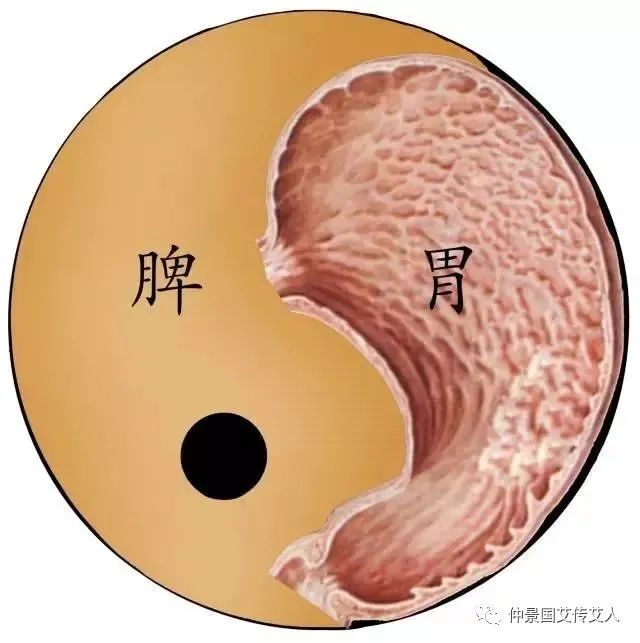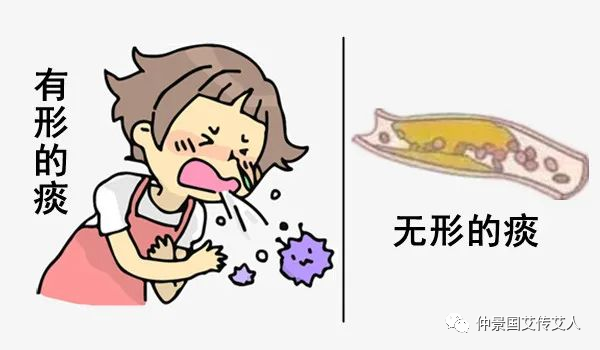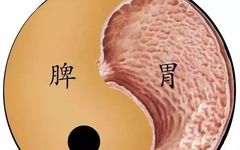 In the theory of Zangxiang in Traditional Chinese Medicine (TCM), the “spleen” is not equivalent to the anatomical spleen, but rather a functional concept. For instance, the spleen is responsible for ascending clear qi, while the stomach is responsible for descending turbid qi. The spleen also governs the transformation and transportation of water and dampness. If there are obstacles in the circulation and excretion of body fluids, these fluids cannot properly nourish the body, leading to abnormal accumulations that become pathological substances. This abnormal accumulation of fluids is collectively referred to as “phlegm-dampness”.Among these, the turbid, viscous, and thick portions are called “phlegm” (痰), while the clear, thin, and transparent portions are referred to as “dampness” (饮).
In the theory of Zangxiang in Traditional Chinese Medicine (TCM), the “spleen” is not equivalent to the anatomical spleen, but rather a functional concept. For instance, the spleen is responsible for ascending clear qi, while the stomach is responsible for descending turbid qi. The spleen also governs the transformation and transportation of water and dampness. If there are obstacles in the circulation and excretion of body fluids, these fluids cannot properly nourish the body, leading to abnormal accumulations that become pathological substances. This abnormal accumulation of fluids is collectively referred to as “phlegm-dampness”.Among these, the turbid, viscous, and thick portions are called “phlegm” (痰), while the clear, thin, and transparent portions are referred to as “dampness” (饮).
Therefore, “phlegm-dampness” does not solely refer to the phlegm produced in the lungs that is expelled through coughing and can be visually observed. In TCM, “phlegm” also includes pathological products that arise due to metabolic disorders of body fluids, characterized by turbid, viscous, and thick properties.
Since this type of “phlegm” is not as readily recognized as the phlegm in the lungs, TCM refers to it as “invisible phlegm” (无形之痰), while the phlegm produced in the lungs that can be expelled through coughing and is visible is called “visible phlegm” (有形之痰). Together, these two concepts form the TCM understanding of “phlegm”.
Visible phlegm primarily exists in the lungs and may arise from either internal metabolic disorders of body fluids or external pathogenic factors invading the lungs. Once produced, this phlegm can be expelled through coughing and is observable, making it easier to understand.
We are quite familiar with visible phlegm, especially during colds and coughs, but have we noticed a detail? The phlegm coughed up from the lungs can vary greatly in characteristics.
For example, some phlegm is white and viscous, some is thin and white, some is foamy, some is yellow and thick, some is gray-black, and some is yellow-green… Why does phlegm, which is essentially the same, exhibit so many variations?
Upon careful analysis, the various characteristics of phlegm can be summarized into two aspects: one is the texture, which can be thick, thin, or foamy; the other is the color, which can be white, gray-black, yellow, or yellow-green.

1
Visible Phlegm
Let’s consider a common phenomenon: dissolving sugar in water. This creates a colorless and transparent liquid. If we heat this sugar water, what happens? We can observe that the sugar water gradually becomes thicker, and its color changes from transparent to light yellow and then to deep yellow.
From this phenomenon, we can deduce that the thickness and color of phlegm in the body are closely related to the presence of “heat” within the body. If there is heat in the body, the phlegm will be yellow and thick; if there is no heat, the phlegm will be thin and white. The greater the degree of yellow thickness, the higher the level of heat in the body.
According to this principle, TCM classifies phlegm that is white and thin, or foamy, or viscous as “cold phlegm” (寒痰), while phlegm that is yellow and thick, or even yellow-green, is classified as “heat phlegm” (热痰).
Since cold phlegm and heat phlegm reflect completely opposite natures, their treatments are also entirely different. To treat cold phlegm, warming methods are used, with commonly used herbs including Gan Jiang (干姜), Xi Xin (细辛), Jiang Ban Xia (姜半夏), Chen Pi (陈皮), Bai Jie Zi (白芥子), and Lai Fu Zi (莱菔子); while for heat phlegm, clearing heat and transforming phlegm is the approach, with commonly used herbs including Zhe Bei Mu (浙贝), Chuan Bei Mu (川贝), Tian Zhu Huang (天竺黄), Dan Nan Xing (胆南星), Gua Lou (瓜蒌), and Tian Hua Fen (天花粉).
However, whether it is cold phlegm or heat phlegm, TCM emphasizes the concept of “transformation” in treatment. What does “transformation” mean? In the past, before the advent of running water, if the water quality was murky, we often added a small amount of alum to the water tank, and after a while, the water would become clear. The alum acted to decompose and settle the impurities in the murky water, which is the essence of “transformation”.
The phlegm-transforming herbs used in TCM for various phlegm conditions serve a similar role to that of alum, helping to decompose and settle phlegm turbidity, thereby alleviating diseases caused by phlegm turbidity.
Western medicine also recognizes two types of phlegm: one is infectious phlegm, caused by bacteria, fungi, mycoplasma, or chlamydia infections; the other is exudative phlegm, often resulting from excessive secretion of mucus by respiratory mucosal cells.
In this case, antibiotics can be effective against phlegm caused by bacterial infections, but there are limited options for phlegm caused by fungi, mycoplasma, or chlamydia infections, as well as for exudative phlegm. How does TCM view and treat these phlegm-related diseases?
TCM believes that microorganisms such as fungi, mycoplasma, and chlamydia naturally exist in the air and do not harm the body under normal circumstances. Only when there is excessive accumulation of dampness in the body, creating an overly humid internal environment, do these microorganisms proliferate and harm health, leading to various diseases.
Therefore, the true root cause of these diseases lies in the “dampness” of the internal environment. Just as in the rainy season, the humid environment allows for the proliferation of fungi, making things prone to mold. If you can recognize that a humid environment is the main cause of fungal proliferation in nature, why would the human body be any different?
How should we treat phlegm caused by internal dampness? In daily life, dampness is often associated with overcast weather. If the sky is clear and sunny, there will be no damp environment.
There is a saying: “When the sun is high, the haze dissipates,” which illustrates this point. The sun can drive away dampness primarily through its heat. Therefore, when treating this type of phlegm, we should use warming herbs to create a “sunny” effect within the body, allowing the damp “haze” to dissipate. This eliminates the root cause of dampness accumulation in the body, preventing the survival and proliferation of fungi and other microorganisms, thus providing rapid relief for phlegm caused by fungal, mycoplasma, or chlamydia infections, as well as exudative phlegm.
The Han Dynasty medical sage Zhang Zhongjing already proposed in the “Jin Gui Yao Lue” that the principle for treating this condition is “for phlegm-dampness, one should use warming herbs to harmonize it.” This perspective remains remarkably insightful even today, and we cannot help but admire the ancient methods and thoughts in exploring the mysteries of life and disease.
2
Invisible Phlegm
Having discussed visible phlegm, what is “invisible phlegm” and how can we determine its presence? TCM identifies four criteria for determining the existence of invisible phlegm in the body.
①Obesity. The TCM saying “obese individuals have more phlegm-dampness” refers to the presence of invisible phlegm in obese individuals, as fat possesses the characteristics of phlegm: turbid, viscous, and thick. It is formed from the accumulation of turbid substances in the body’s dampness.
②Thick and greasy tongue coating. A thick and greasy tongue coating is the most direct manifestation of excessive turbid dampness in the body.
③Masses. Any mass that is not red in color, protruding from the skin surface, and is nodular in shape, soft or firm to the touch, is referred to in TCM as a “phlegm mass” (痰块) if it contains water, mucus, or viscous substances.
④Slippery pulse. TCM classifies pulse sensations into more than twenty types based on different feelings under the fingers, with slippery pulse being one of them. The description of a slippery pulse in TCM is “smooth and flowing, like beads rolling on a plate,” indicating that the pulse feels as if beads are rolling smoothly on a surface. The presence of a slippery pulse is one of the characteristic manifestations of phlegm turbidity in the body and is a primary basis for TCM diagnosis of phlegm.
According to TCM understanding of phlegm, combined with Western medicine’s microscopic examinations, the concept of invisible phlegm can be made more concrete and intuitive. For example, diseases such as hyperlipidemia, cysts, lymph node tuberculosis, and bone tuberculosis all exhibit characteristics of turbidity, viscosity, and thickness, and can thus be considered phlegm-related diseases. In this way, Western medical examinations become an extension of TCM’s observation, listening, inquiry, and pulse diagnosis.
Through TCM’s understanding of the mechanisms of phlegm formation, we can relate the occurrence of these diseases to the overall balance of the body, finding fundamental treatment methods. For instance, hyperlipidemia, cysts, and lymph node tuberculosis all align with the characteristics of TCM phlegm, and their fundamental causes are related to the spleen’s dysfunction in transformation and transportation, leading to excessive accumulation of dampness and phlegm in the body. Therefore, treatment can be approached through strengthening the spleen, assisting its function, and transforming phlegm to soften hard masses. Moreover, by addressing the root cause of phlegm formation, the treatment effects are long-lasting.
The spleen’s insufficient function in transforming dampness leads to the accumulation of dampness in the body, and the turbid substances within this dampness can condense in certain areas, forming phlegm masses, such as the aforementioned cysts, lymph node tuberculosis, and bone tuberculosis. They can also enter the meridians and blood vessels, traveling throughout the body with the circulation of qi and blood, as mentioned earlier regarding blood lipids.
These turbid substances possess viscous properties, often obstructing the flow of qi and blood in the meridians and blood vessels, leading to pathological changes due to ischemia and hypoxia in the organs and tissues, resulting in various diseases. For example, if phlegm accumulates in the head, it can affect blood supply to the brain, leading to symptoms such as dizziness, forgetfulness, drowsiness, and even coma, hemiplegia, or speech difficulties, which Western medicine refers to as cerebral infarction. Many cases in TCM are attributed to phlegm.
If phlegm accumulates in the limbs, it can lead to blood supply disorders in the limbs, resulting in symptoms such as numbness, cold extremities, etc. If phlegm accumulates in the blood vessels, it can lead to insufficient blood supply to the heart, causing symptoms such as palpitations, anxiety, arrhythmia, and chest tightness, which in many cases are closely related to phlegm, as described in Western medicine as coronary heart disease.
Moreover, phlegm can also affect a person’s mental state. If the turbid qi of phlegm-dampness obstructs normal mental activities, it can lead to symptoms such as incessant talking, depression, and unexplained sadness, which are classified as depressive disorders in TCM. Since TCM considers the “heart” to be the ruler of the mind, this type of mental disorder caused by excessive “phlegm turbidity” is referred to as “phlegm obstructing the heart orifices” (痰迷心窍).
3
Characteristics of Phlegm
Regarding the characteristics of phlegm, the great physician of the Yuan Dynasty, Zhu Danxi, stated: “Phlegm, as a substance, rises and falls with qi, reaching everywhere.” It is precisely because of the characteristic that phlegm “reaches everywhere” that TCM attributes many strange diseases or conditions with poor treatment outcomes to “phlegm”.
Thus, there is a saying in TCM: “Strange diseases often arise from phlegm.” Zhu Danxi also proposed the theory that “many diseases are accompanied by phlegm,” which adds a new perspective to the diagnosis and treatment of diseases. Sometimes, even when the diagnosis is correct and the medication is appropriate, the clinical outcomes may not be ideal. In such cases, we can consider incorporating phlegm-transforming methods, which often yield unexpectedly good results.
4
Meniere’s Disease as Phlegm-Dampness
Meniere’s disease, previously known as Ménière’s disease, is characterized clinically by: paroxysmal vertigo that occurs frequently, during which the patient feels that surrounding objects are spinning, similar to the sensation of being on a moving vehicle, accompanied by nausea, vomiting, and headache, with activities exacerbating the severity of vertigo and vomiting.
Therefore, during an episode, patients often lie still with their eyes closed, afraid to move, and some may feel a sensation of blockage and pressure in the ear, or experience nystagmus.
Western medicine believes this condition is caused by increased lymphatic fluid in the inner ear, leading to ear-related vertigo.
According to the description of the “Mao Xuan” syndrome in the “Jin Gui Yao Lue”, “Mao” refers to nausea and vomiting, and “Mao Xuan” indicates a disease characterized by vertigo accompanied by nausea and vomiting.
Zhang Zhongjing believed it was caused by “water retention in the heart area”, which closely resembles Meniere’s disease, suggesting that this condition is due to water retention in the inner ear. The use of the “Ze Xie Decoction” from the “Jin Gui Yao Lue” can achieve excellent clinical results.
The composition of Ze Xie Decoction consists of two herbs—Ze Xie (泽泻) and Bai Zhu (白术). Ze Xie, as recorded in the “Shen Nong’s Herbal Classic”, is said to “treat wind, cold, dampness, and eliminate water”; Bai Zhu, as mentioned in the “Famous Physician’s Record” by the Jin Dynasty physician Tao Hongjing, is said to “eliminate phlegm and water, expel wind-water accumulation, and warm the stomach to digest grains”.
These two herbs work together: Ze Xie promotes urination to eliminate internal water retention, while Bai Zhu strengthens the spleen and eliminates phlegm-water as a supplementary action. This combination effectively addresses both the symptoms of water retention and the root cause of phlegm production due to spleen deficiency, resulting in rapid therapeutic effects despite the small number of ingredients.
Self-Assessment for Phlegm-Dampness Constitution
1. Dizziness, headache, and heaviness in the head.
TCM believes that the head is the residence of clear yang and the spirit, requiring nourishment from qi, blood, and essence, and should not be disturbed by turbid evils. If phlegm-dampness ascends and obstructs the clear yang, it results in dizziness, headache, and a feeling of heaviness.
Headaches, dizziness, and heaviness in the head are often seen in cases of hypertension.
Western medicine attributes hypertension to vascular spasms or loss of elasticity in blood vessels, leading to obstructed blood flow and increased pressure.
From a TCM perspective, the turbid evil of phlegm-dampness is heavy and tangible, and combined with the characteristic of phlegm being able to rise and fall with qi, it can obstruct the clear yang, filling and blocking the blood vessels, which may also lead to vascular spasms and loss of elasticity, resulting in elevated blood pressure.
Therefore, for hypertensive patients who exhibit symptoms of phlegm-dampness obstructing the clear yang in the head, treating them with methods to clear and transform phlegm-dampness can yield significant results.
Symptoms of dizziness, headache, and heaviness in the head caused by phlegm-dampness may persist or fluctuate, but they are fundamentally different from those caused by qi and blood deficiency. Using tonics in such cases may not only be ineffective but may also exacerbate the condition, as it is a case of obstructive phlegm.
If stubborn phlegm and stagnant blood accumulate, they can condense into tumors, residing in the brain or other parts of the body. Without resolving and dispersing the stubborn phlegm and stagnant blood, the tumor cannot be eliminated.
2. Nausea or vomiting of phlegm and saliva, or a gurgling sound in the stomach and intestines, or a sticky, greasy mouth, or dry mouth with no desire to drink.
The turbid evil of phlegm-dampness lingers in the stomach and intestines, causing the stomach to lose its harmony and descent, leading to obstructed qi flow, resulting in nausea or vomiting of phlegm and saliva, or a gurgling sound in the stomach and intestines.
Phlegm-dampness rising can cause a sticky sensation in the mouth. Phlegm turbidity is originally transformed from body fluids, but it can also obstruct the movement of body fluids, leading to a dry mouth, as if drinking too much water only increases the phlegm.
The above symptoms are often clinically diagnosed as gastrointestinal neurosis, and medication is often ineffective. However, treating with methods to warm and transform phlegm-dampness, or additionally focusing on soothing the liver and regulating the spleen, can yield rapid results.
3. A sensation of obstruction in the throat, difficulty swallowing, with symptoms appearing intermittently.
The occurrence of this condition generally begins with liver qi stagnation and emotional disharmony, leading to liver depression and spleen deficiency. When the liver and spleen are not in harmony, the spleen’s qi is also suppressed, leading to the accumulation of fluids and phlegm, which obstructs the throat. Thus, there is a sensation of obstruction in the throat and difficulty swallowing.
The characteristic of phlegm is that it can accumulate and disperse, and since this condition begins with liver qi stagnation, followed by spleen dysfunction leading to phlegm accumulation, it manifests as a sensation of obstruction in the throat, which can appear or disappear depending on emotional states.
This type of symptom is often seen in female patients. If the condition persists for a long time, it can lead to yin deficiency with phlegm. If treatment focuses solely on transforming phlegm, it may further deplete yin fluids, worsening the sensation of obstruction and dryness in the throat. It is essential to simultaneously incorporate sufficient nourishing yin substances to nourish while transforming, allowing for the resolution of phlegm and obstruction.
4. Palpitations, insomnia, or fainting, convulsions, or mental disorders, but neurological examinations show no abnormalities, nor are there signs of yin deficiency or yang hyperactivity.
“Phlegm qi obstructing the heart” and “phlegm obstructing the heart orifices” refer to these types of symptoms. In TCM, the “heart” also refers to brain function, as in “the heart governs the spirit” and “the brain is the residence of the spirit”.
Thus, phlegm qi obstructing the heart and phlegm obstructing the heart orifices often manifest as disorders of brain cortex function. For these types of symptoms, treatment with methods to clear phlegm and open the orifices can often yield satisfactory results.
5. Stools coated with phlegm and saliva, or constipation with difficulty passing stools.
Phlegm turbidity lingers in the stomach and intestines, leading to stools coated with phlegm and saliva. Treatment with methods to strengthen the spleen and transform phlegm should yield results. If phlegm turbidity lingers in the intestines, obstructing the qi flow, it can lead to constipation (though the stools are not dry). In this case, the more one tries to moisten the stools, the more constipated they become. If treated with methods to move qi, transform phlegm, and clear the lungs, the stools can quickly become normal.
6. Low-grade fever and body heaviness, or a sensation of heat without a significant increase in body temperature.
Phlegm is a yin evil, characterized by its viscous nature and tendency to remain hidden. When phlegm turbidity is retained, it obstructs yang qi, preventing it from expanding, resulting in a condition where yin does not match yang, leading to stagnation and heat. Phlegm turbidity obstructing yang can cause low-grade fever, which is distinct from the heat caused by external pathogens or the symptoms of blood deficiency, yin deficiency, or qi deficiency. The characteristic is heaviness in the body without significant fever. Many cases of unexplained low-grade fever, where signs of yin deficiency or qi deficiency are absent, fall into this category.
If one carelessly administers yin-nourishing or qi-tonifying herbs, it may further promote phlegm and lead to persistent low-grade fever and heaviness. If one can carefully examine the tongue and pulse, and accurately assess the symptoms, focusing on transforming and dispersing phlegm-dampness will yield satisfactory results.
7. Localized heat or cold in the limbs (or a localized area of the back feeling cold, or numbness without pain or itchiness, or differences in size and sensation in certain areas of the body, but neurological, orthopedic, and dermatological examinations show no abnormalities).
“Phlegm travels with qi and reaches everywhere,” and “the sensations (and symptoms) vary, with numerous pathological changes”. Phlegm turbidity lingers and obstructs, leading to the aforementioned changes. If phlegm turbidity accumulates and does not disperse, the affected area may also exhibit swelling or nodules.
8. Ulcers, erosions, or exudation of viscous phlegm, which do not heal for a long time, or localized skin thickening with scaling but no exudation.
Phlegm-dampness lingers, or heat phlegm condenses, affecting the flow of qi and blood in the affected area, leading to the external manifestation of phlegm turbidity. This can result in persistent exudation of viscous fluids or even ulceration. If this condition persists for a long time, the body’s righteous qi may weaken, and the affected area may become susceptible to external wind, cold, or heat, making it difficult for the qi and blood to return to normal, resulting in prolonged non-healing. This condition begins with phlegm turbidity condensing, leading to qi and yin deficiency, along with stubborn phlegm that does not resolve.
If the affected area exhibits thickened skin with scaling, it indicates qi and yin deficiency, along with the presence of stubborn phlegm.
9. Chest tightness and shortness of breath, with a feeling of fullness in the back, a tendency to sigh or pound the chest. These symptoms are particularly pronounced during overcast or changing weather.
Phlegm-dampness stagnates in the chest, obstructing the flow of yang qi (causing lung qi to lose its ability to descend), leading to a sensation of chest tightness and shortness of breath. If phlegm turbidity stagnates in the back, it can lead to a feeling of fullness or coldness in the back. Sighing and pounding the chest can temporarily relieve the qi flow, which is why patients often sigh loudly or pound their chest for relief. If phlegm turbidity obstructs the flow excessively, it can completely block the flow of yang qi, leading to temporary stagnation of qi and blood flow, resulting in pain in the chest area, which can lead to severe acute myocardial infarction.
10. Masses or nodules, either beneath the skin or within the abdomen, can also occur in other tissues or organs, with no changes to the skin surface, or a slight cold sensation, or a dull skin color.
Warm Reminder
Thank you for your attention, and we hope you can share this article to help more people gain knowledge and grow!
Share and Spread HealthZhongjing Guo AiZhongjing’s Hometown, World of MoxibustionLet the world become healthier and happier through moxibustion!
When healthy, moxibustion can strengthen the body;
When ill, moxibustion can adjust the condition and drive away diseases.

Follow our public account to learn more!

